The Building Blocks of Smart Mobility: TriMet’s Open Systems Approach to Transit Modernization
30 minutes Author: Shared-Use Mobility Center Date Launched/Enacted: Oct 20, 2025 Date Published: October 20, 2025
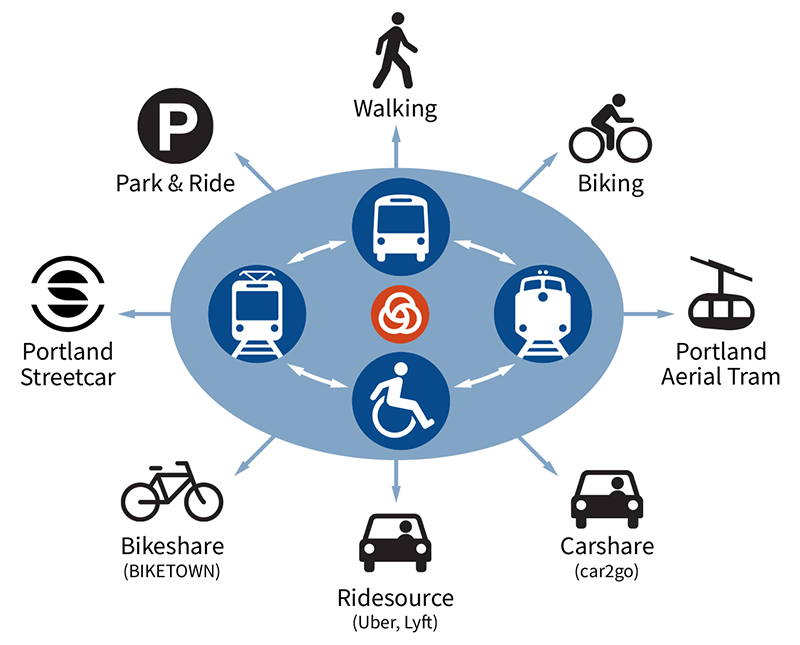
Summary
- The Tri-County Metropolitan Transportation District of Oregon (TriMet), in Portland, OR, has earned a reputation as one of the country’s most innovative transit agencies through a longstanding pursuit of transformative transit technology solutions.
- TriMet was integral in developing the General Transit Feed Specification, the industry standard data format for sharing schedule, geographic, and fare information for fixed-route transit.
- In the mid-2000s, TriMet began developing the OpenTripPlanner, a trip planning and management platform focused on integrating multiple modes, including biking, walking, and transit.
- TriMet received a Mobility On-Demand Sandbox award from the Federal Transit Administration to further develop the OpenTripPlanner to include shared mobility modes like carshare, ridehail, bikeshare, and scootershare.
- In 2021, TriMet received a second Federal Transit Administration award through the Integrated Mobility Innovation program to build upon the OpenTripPlanner by developing an integrated payment system as well as an Origin-Destination-Transfer Model.
- TriMet’s focus on open architecture and open data means that these projects have fostered a global community of developers to improve upon them and implement them in their own regions. This case study explores how a transit agency can use innovative partnerships and technologies to promote people-centric mobility both locally and globally.

This project is part of the Mobility Innovation Collaborative (MIC). The MIC provides a comprehensive suite of technical assistance resources, promotes knowledge sharing activities, and captures stories and lessons learned from innovative mobility projects across the United States.
Originally published October 2025.
Introduction
Since its establishment in 1969, The Tri-County Metropolitan Transportation District of Oregon (TriMet), in Portland, OR, has earned a reputation as one of the most innovative transit agencies in North America. Not only has TriMet advanced major initiatives related to data standardization, mobility wallets, and mobility-as-a-service (MaaS), but the agency has pursued these transformative projects while adapting to operational challenges and shifting travel patterns.
These initiatives follow TriMet’s larger strategic vision of going beyond simply running buses and trains. With the growing availability of new technologies, data, and services, and with evolving rider preferences, TriMet has leveraged these trends and focused on mode-agnostic, people-centric service. TriMet’s service model recognizes that the agency is uniquely suited to be the region’s mobility manager, and in that capacity can make a multitude of transportation options more convenient and accessible. By embracing new technologies, exploring new ways to integrate modes, leveraging novel data sources, and making fare payments as seamless as possible, TriMet has emerged as a national leader in mobility innovation.
This case study explores some of TriMet’s initiatives to promote innovation in the transportation industry, highlighting the agency’s groundbreaking work in developing data standards for trip planning, its deployment of an industry-leading and widely adopted trip planning engine, its pursuit of multimodal integrated payment, and its mobility innovation efforts in partnership with the Federal Transit Administration’s (FTA) Office of Research, Demonstration and Innovation.
General Transit Feed Specification
One of TriMet’s most notable initiatives was the development of the General Transit Feed Specification (GTFS), in partnership with Google. GTFS is a data specification for trip information like schedules, stops, and fares for fixed-route transit, which has since become the industry standard and is now used by thousands of transit agencies around the world.
GTFS emerged due to a frustration with the limitations of traditional methods agencies had used to publicize their services and schedules. In the mid-2000s, Bibiana McHugh, Manager of Mobility and Location-Based Services at TriMet in Portland, noted difficulties in navigating transit systems, particularly in unfamiliar cities. Though transit agencies published transit maps, these were generally static, and did not include helpful trip information like travel times, fares, or real-time status of vehicles; if schedule and stop information was posted on agencies’ websites, it was often only available as static PDF documents for each individual route. Car drivers already had access to helpful tools through a growing body of online mapping platforms like Mapquest, Yahoo Maps, or Google Maps, and McHugh sought to bring these features to public transit. TriMet partnered with Google to develop a standardized, machine-readable representation of TriMet’s route, stop, and schedule data and incorporate it into Google Maps. In December 2005, Portland became the launch city for Google’s “Transit Trip Planner,” a trip planning pilot project that preceded full transit integration into Google Maps.
Both TriMet and Google learned several lessons almost immediately. For one, while the transit agency needs to be deeply involved and communicative of its needs, transit agencies are not software developers. Per McHugh, “[t]ransit data is extremely complex…There is a temporal element and spatial element and it takes a relational database to manage all of that information.” Working with a partner like Google allowed TriMet to quickly demonstrate the value and scalability of open data in transit trip planning.
The plan to share TriMet’s scheduling data was initially met with internal resistance at the agency. Many within TriMet voiced concern about how the data might be used. However, the national landscape of data management was in a period of change; in addition to grassroots movements towards more effective data application, a 2013 executive order made open and machine-readable data the new default for government information. TriMet’s TransitTracker online information system was already open source at this point, and the partnership with Google made sure that the information could evolve constructively. TriMet opened its data to third-party developers, but insisted on an open standard for all data and any product coming out of it. TriMet continues this policy in future technology projects to avoid vendor lock and a “walled garden” where information can only be accessed through certain specific applications.
Google eventually added additional cities to the Transit Trip Planner, and released the data format as Google Transit Feed Specification, later changing the name to General Transit Feed Specification to highlight the specification’s open source nature. GTFS quickly became the industry standard, and in 2023, FTA required that all US transit agencies that operate fixed-route service must maintain and submit a GTFS dataset to the National Transit Database.
OpenTripPlanner
TriMet’s OpenTripPlanner (OTP) marks one of the first and most notable industry attempts at creating a MaaS platform, where users can seamlessly plan, book, and pay for multiple mobility services through a single integrated mobile or web-based app. OTP is a trip planning and trip management platform focused on integrating multiple modes, including biking, walking, and transit. TriMet initially released OTP in 2009 to help TriMet riders make informed transportation decisions, particularly for first and last mile connections.
Project partners designed OTP as an open-source project (i.e. with source code publicly available and licensed for free use, modification, and redistribution), and developed the platform to rely on open datasets, like GTFS and OpenStreetMap, so that other transit agencies can easily deploy their versions of the platform. The initial development and deployment was funded through an Oregon Metro Regional Travel Options grant, a statewide program that funds projects to support efforts that increase active transportation and shared mobility use.
OTP has a variety of features to make multimodal trip planning and trip management as comprehensive as possible. In addition to planning and scheduling trips, OTP allows users to alter results based on certain preferences. For instance, for trips with a bicycle segment, a user can optimize the trip for the fastest route, the safest route, or the route with the fewest hills, and can further modify the route to take the rider’s average bicycle speed into account. With several options depending on selected modes, users can choose a preferred balance of travel time, number of transfers, and other considerations. For trips connecting to transit, travelers can provide a preferred walk or bike distance, starting from one-tenth of a mile.
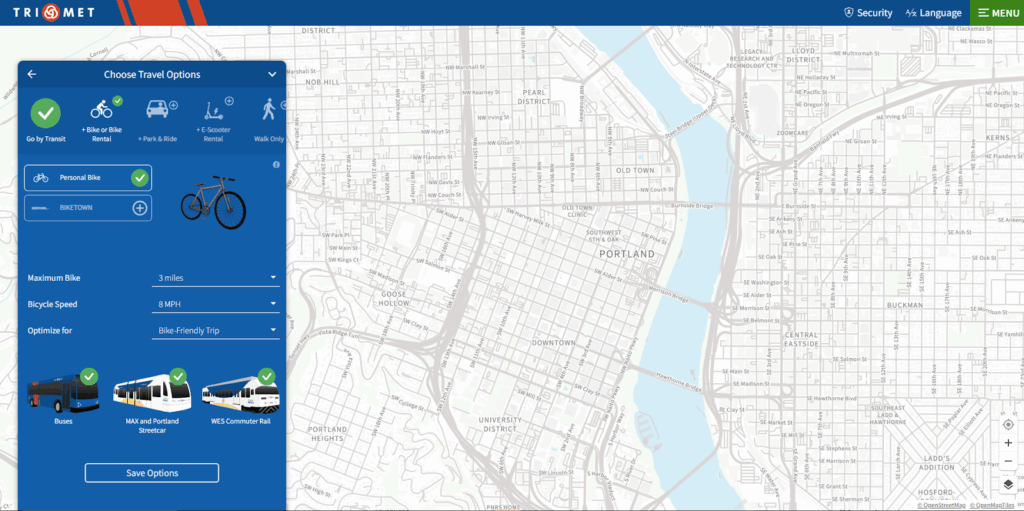
OTP screenshot. Credit: TriMet
Since its launch, several transit agencies around the world have adopted OTP or built their own platforms on top of it, including Houston Metro, Southeastern Pennsylvania Transportation Authority (SEPTA), The Helsinki (Finland) Regional Transport Authority, and the New York State Department of Transportation in its 511 Transit Trip Planner. The project’s source code continues to be actively maintained and modified and is supported by a sizable community of developers and users.
Mobility On-Demand Sandbox Program
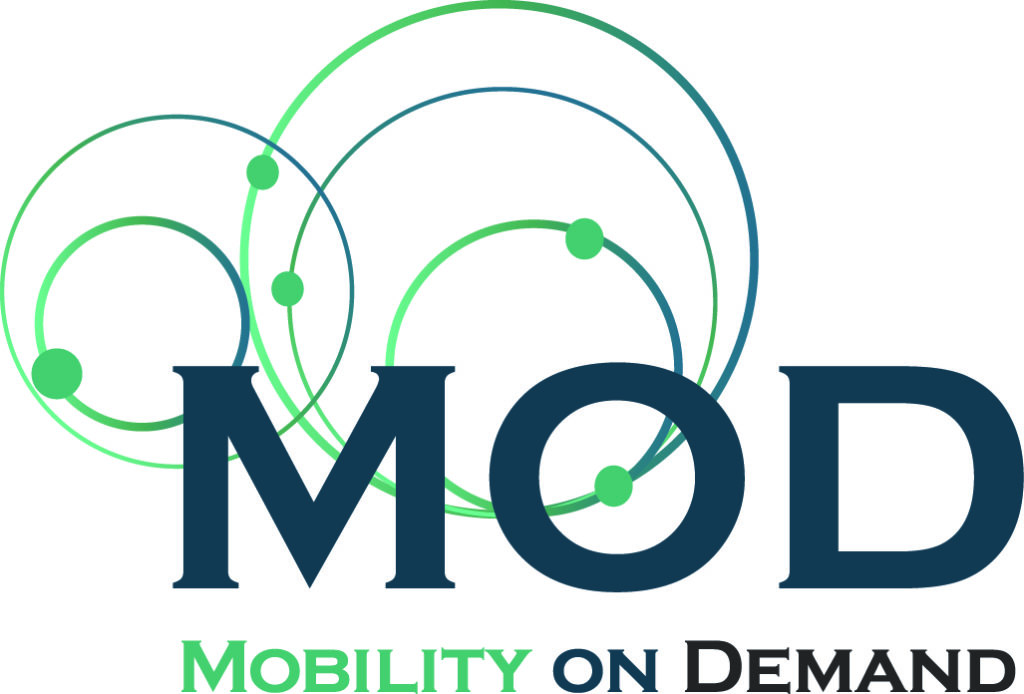
Background
In 2016, FTA launched the Mobility On-Demand (MOD) Sandbox program to explore how transit agencies could incorporate new technologies to complement and support public transit. TriMet was selected as one of 11 MOD Sandbox award recipients to build upon OTP, and received $678,000, which was matched by $324,000 of in-kind contributions. Through the MOD Sandbox program, TriMet expanded on previous OTP work to support the integration of more modes into the trip planner. Through this work, OTP became the first trip planner in the US to incorporate shared mobility providers alongside transit. With this, users could plan trips using OTP that not only involved walking and public transit, but could include trip segments provided by mobility services like bikeshare, ridehail, and carsharing.
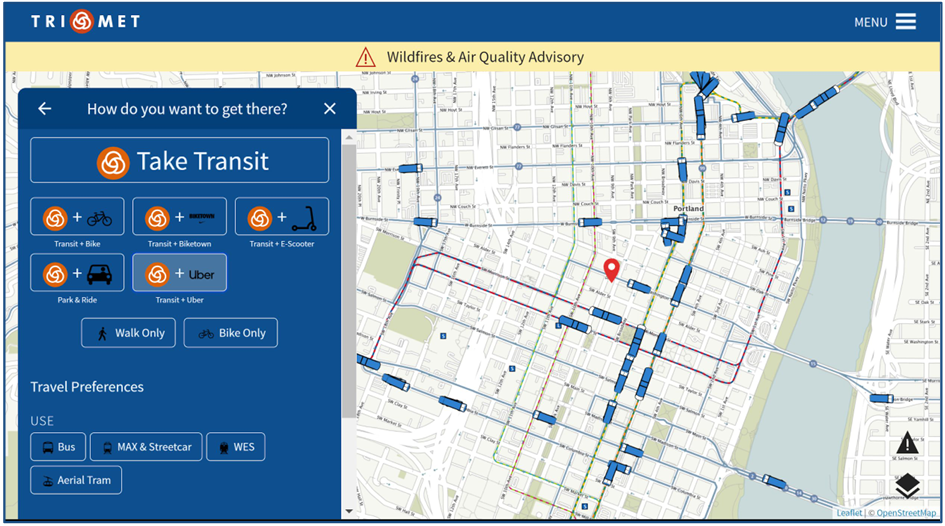
Early version of TriMet’s OTP. Credit: TriMet
Goals
TriMet identified several goals for the MOD Sandbox program to improve the usability, design, functionality, and user experience of OTP. First, TriMet aimed to make various enhancements to the platform, including incorporating additional shared modes, optimizing trip planning based on real-time vehicle locations, improving pedestrian routing, and enhancing the user interface.
Secondly, TriMet aimed to develop a non-proprietary geolocation system, which would make it easier for other transit agencies to implement their own trip planning systems.
Thirdly, TriMet improved data from OpenStreetMap and OpenAddresses to better enhance trip planning and geocoding, including adding information on sidewalks, speed limits, and businesses. OTP was designed to use OpenStreetMap data from the beginning, and prior to the MOD Sandbox project, TriMet discovered that using OpenStreetMap data produced better results than most geospatial data commonly used by transit agencies and other government entities. Improving data from these sources included incorporating existing jurisdictional data, often manually, to fill in gaps.
TriMet’s final goal was to develop a plan for an integrated payment platform that could be incorporated into a MOD platform. Project partner moovel led in developing this plan, which lays out design principles and a proposed system architecture for a scalable payment platform.
Outcomes
During the MOD Sandbox program, TriMet and its partners expanded OTP to integrate shared mobility services, making it a first-of-its-kind multimodal trip planner. The team also built on Pelias, an existing open-source geocoder, both to assist with trip planning and to lower the cost barriers for agencies implementing similar solutions. Finally, TriMet enhanced its OTP platform to make it as functional, practical, and user-friendly as possible. The innovative tools developed through the MOD Sandbox program make multimodal journeys in Portland easier and more feasible, and have advanced the transit industry as a whole. For users, this meant that the OTP could now produce faster trips than transit alone and cheaper trips than private mobility providers alone. The multimodal OTP is a framework for better trip planning, improved pedestrian routing, and more accurate mobility data, and TriMet’s focus on using open architecture and open data sources ensures that these advancements and lessons can be further developed by other mobility providers.
At the conclusion of the program, a team of independent evaluators prepared a report to assess the OTP project, highlighting TriMet’s process, examining progress on performance indicators, and showcasing many of the project’s successes. The evaluators used survey data, interviews, and extensive OTP testing to determine how effective TriMet’s efforts were and how functional OTP had become as a multimodal trip planner.
Among other major takeaways, researchers found that the MOD Sandbox project ultimately improved the availability of information on shared modes and multimodal connections for OTP users. Users’ survey responses and platform testing note that nearly every time a trip was requested, OTP could accurately show a valid route, often with faster travel times relative to trip planners without shared modes. During walking segments of trips, OTP reliably directed users to lower-stress routes. Furthermore, the real-time information included in the platform was accurate and practical to users. Survey respondents reported that using the trip planner helped in overcoming first- and last-mile challenges, and generally praised its design and user interface. The geocoder developed during the program performed comparably to other geocoders. For the portion of the project focused on improving open source data for better trip planning and geocoding, the evaluation found that the data enhancements were mostly effective. Specifically, evaluators manually examined road segment data throughout the region covered by the trip planner and found that sidewalk data was highly accurate.
Challenges and Lessons Learned from the MOD Sandbox Program
TriMet faced several challenges in expanding OTP, and learned a number of critical lessons through the MOD Sandbox program that can help other entities pursuing similar trip planning projects.
As expected with such an innovative and novel technology-based project, TriMet faced some initial setbacks matching project expectations with the limitations of the OTP technology. In particular, OTP had some issues with future trips that combined transit and ridehail. While the platform can easily work with TriMet’s schedules for fixed-route buses and light rail, ridehail services like Uber are less predictable. Planning for future trips cannot account for real-time ridehail vehicle availability, which can result in variance in how the platform functions. TriMet found these types of trips particularly difficult to replicate during platform testing.
Another issue involved wheelchair accessible vehicles. During testing, when the project team created a trip with a ridehail component, OTP would often not be able to generate the same trip when the wheelchair accessible option was selected. This was likely due to the limited supply of wheelchair accessible ridehail vehicles rather than a technological limitation of the platform.
As the project lead, TriMet learned valuable lessons about project management and coordinating with a large group of partners. Partners were located around the country, making it challenging to coordinate and collaborate. Even before the widespread embrace of remote collaboration tools during the pandemic, TriMet saw value in web-based and cloud-based communication and project management tools, like Slack or Trello, and hosting regular conference calls, group work sessions, and check-in meetings. The project team also made sure to have in-person meetings with all stakeholders at critical points throughout the project. Ultimately, this vigorous approach to communication and collaboration was highlighted as one of the major successes of the project, and was critical in keeping partners aligned and ensuring the project stayed on track.
Despite strong collaboration practices, TriMet did encounter challenges in coordinating with certain stakeholders. Specifically, TriMet faced difficulties creating data sharing agreements that both met the technical necessities of OTP and were amenable to private shared mobility providers. The open architecture of OTP relies on the visibility of operational data, and private mobility providers often resist disclosing this information in ways their competitors might access. Thus, they can be reluctant to share data, especially on a platform that involves competing providers. For the MOD Sandbox project, it took more than a year of negotiations with providers to reach data agreements that were agreeable to all partners. Contracting often takes longer than anticipated, and one of TriMet’s critical takeaways was the value in starting these negotiations as soon in the process as possible.
Even with these contracting setbacks, using open source software and open data overall brought significant benefits. Notably, TriMet found significant cost savings from using open data and software rather than proprietary data and technology. Open source tools can be replicated and scaled more easily, a key objective of OTP development. Because of its replicability, the OTP development process helped grow a global community of developers and users. As implementers develop similar projects, allocating additional funds for code integration and participation in these communities should be a key budget consideration.
A final and critical lesson learned through the MOD Sandbox program is that technology alone is not enough to encourage multimodal travel. Many users are reluctant to transfer between modes, and even if a user-facing multimodal platform is available and easy to use, changing travel behaviors is significantly more difficult. When the project team administered surveys to users, many respondents did not anticipate finding combining modes very useful in their travel plans. As with any technology project, implementers should think about the users beyond how they interact with the platform. Accompanying technology with marketing, education, and incentives is integral to maximizing the benefits of an integrated and interconnected mobility network.
Integrated Mobility Innovation Program
Background
To build on the work completed under the MOD Sandbox program, TriMet applied for funding through FTA’s Integrated Mobility Innovation (IMI) program in 2021. IMI was established to explore how new service models, technologies, and other innovative solutions could be brought together to enhance existing transit services, through three main focus areas: MOD, transit automation, and mobility payment integration. TriMet was awarded $1.8 million through IMI to develop an integrated mobility payment system building on OTP, and to explore other avenues to improve transit service planning.
Integrated Payments
TriMet had previously launched Hop Fastpass, an account-based fare system that uses open application programming interfaces (APIs), open payments, virtualized fare cards, and fare capping. The Hop system has supported open payments since its implementation in 2017, but only for full adult fares. Since the system did not have the capability to determine if riders using their own bank cards or mobile wallets were eligible for discounted fares, these riders’ payment options were limited, and they could only access their fares using a closed-loop Hop card. And while the Hop system supported daily fare capping, it did not support it on a monthly basis, whereas TriMet’s closed loop system supported fare capping over both time periods. The IMI project aimed to improve the functionality of the Hop system to expand its open payment capabilities, thereby reducing barriers and broadening transportation access. Additionally, TriMet explored options for implementing open loop payment solutions for unbanked and underbanked riders. Through the IMI program, the agency not only set out to explore the benefits and challenges of integrated fare payment systems, but also to set the developmental foundation for a true MaaS platform.
Smart Mobility Platform and Origin-Destination-Transfer Model
Another key piece of TriMet’s IMI project was working with software company UrbanLogiq on the development of the Smart Mobility Platform, a set of tools for holistic service planning, including an origin-destination-transfer (ODX) analysis tool. ODX models predict how riders move throughout a transit system, including analyses of not only where passengers enter and exit, but also where they may transfer to different routes, modes, or services. These models can give agencies a clearer view into how riders use their systems, allowing them to better analyze how their systems can function more effectively and efficiently. The Smart Mobility Platform works by tapping into various existing datasets, including Hop transactions, TriMet vehicle location data, OpenStreetMap data, and static GTFS data. The model uses this collection of anonymized data to determine when and where riders board a vehicle and makes an inference based on the availability of additional data where transfer points are, or where the trip ends. For instance, if a rider is observed to board a second vehicle some time after tapping a Hop card on a first vehicle, the location is tagged as mid-journey, while if a rider is inferred to have missed several boarding opportunities at a stop, the model assumes the previous (inferred, not observed) alighting was the end of the trip and tags the location as a destination. A more detailed methodology is available here.
When aggregated, these trips paint a picture of how people move and use transit throughout Portland. TriMet planners can use this information to better understand travel patterns, inform future transit planning efforts, and assess the impact of possible service changes before they go into effect. As an example, TriMet analyzed some of the ODX Model’s outputs and found that the majority of trips to the Columbia Industrial Corridor originated from Portland’s Cully neighborhood, an area without a direct transit connection to the district. This insight spurred the agency to connect two lines (Lines 24 and 21) to provide more seamless travel between the two areas.
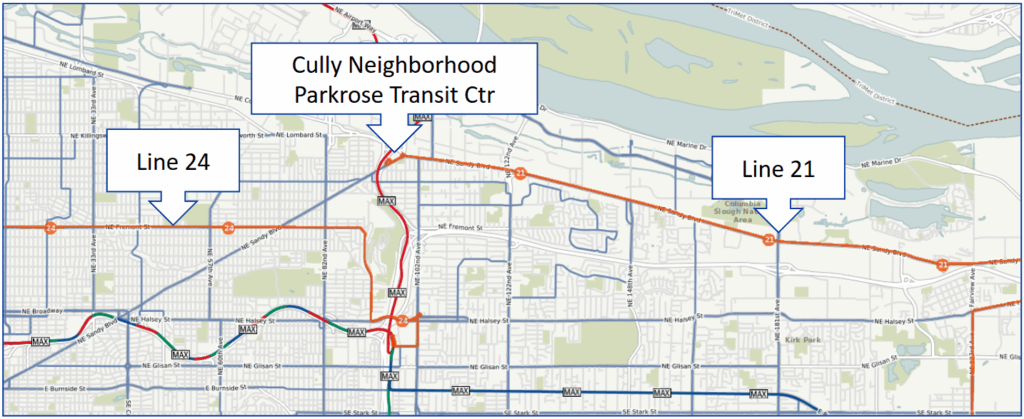
Map showing the Cully Neighborhood Parkrose Transit Center and the two bus lines. Credit: TriMet
Goals
TriMet had a number of goals for the IMI program, categorized under three focuses: Innovative Payment, Customer Experience, and Mobility Data.
Under the innovative payment focus, TriMet intended to make a business case for transit agencies to determine if pursuing integrated payment technologies could be a good investment given the funding, technical, and regulatory challenges in implementing integrated payments. TriMet also aimed to expand upon the open payment capabilities of the agency’s Hop Fastpass system by offering monthly fare capping and adding discounted rates for eligible users using open payments. Additional goals included expanding the functionality and virtual support for Hop Fastpass cards, and demonstrating mobility wallets and retail payments to support transit access for unbanked and underbanked riders.
To improve the customer experience, TriMet focused on developing both technical and policy initiatives to encourage riders to make multimodal trips. One way TriMet pursued this was through improving the trip planning platform developed during the MOD Sandbox program. Trip planning and trip monitoring tools have relied on limited real-time information, causing uncertainty for customers making multimodal journeys. TriMet worked to make vehicle arrival predictions more accurate by analyzing existing arrival predictions and developing a model to generate more accurate predictions. TriMet also worked on improving communication with riders and potential riders on fare capping and other incentive programs, and partnered with the Portland Bureau of Transportation to pilot a program that provided Portland residents with free passes for a variety of shared mobility options if they met criteria like residency in affordable housing or willingness to forfeit parking permits. The final goal to improve the customer experience was to integrate the trip monitoring, communication, and incentive improvements into OTP.
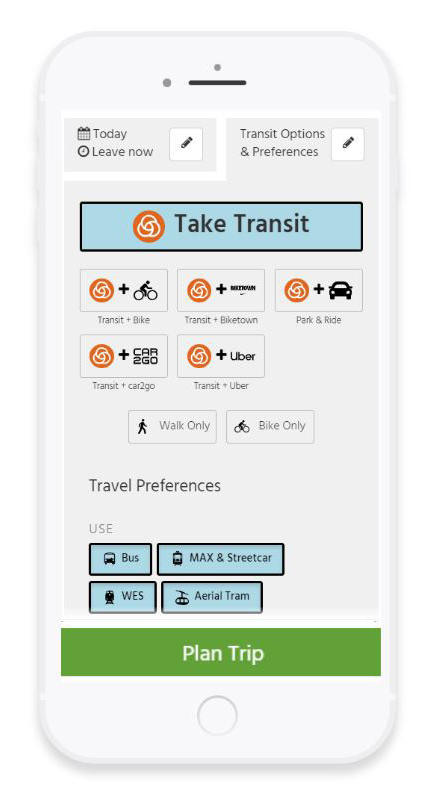
Smartphone app version of TriMet’s OTP. Credit: TriMet
TriMet’s final focus was on using mobility data to evaluate the impacts and effectiveness of mobility management programs. TriMet worked to develop a framework to assess how mobility improves with the implementation of innovative technologies and procedures, defined benchmarks for use in evaluating goals, and used the framework and benchmarks to evaluate the effectiveness of the Innovative Payment and Customer Service initiatives. The ODX Model is one aspect of this focus on data analysis and evaluation.
Outcomes
Because of the technological advancements made during the IMI program, TriMet saw immediate positive impacts to trip planning and service planning. The IMI project focused on making multimodal transportation more convenient, accessible, and appealing to riders, thereby making it more feasible for people to opt out of using personal cars in favor of shared transportation. The enhanced multimodal OTP now offers users more information, better trip decision-making, and more seamless door-to-door options. With these enhancements and the inclusion of the payment platform, TriMet set the foundation for MaaS in the U.S. The IMI project also advanced TriMet as an organization by helping the agency build stronger public-private partnerships and improve collaboration and data sharing with partners. These improvements helped TriMet to better manage mobility throughout the region overall.
The Smart Mobility Platform and ODX Model have provided new insights into customer travel patterns that have improved transportation planning in the region and saved TriMet hundreds of thousands of dollars annually. In addition to the Columbia Corridor service update mentioned above, TriMet used data from the ODX Model to redesign its Line 35 bus route. Previously, Line 35 deviated to create transfer opportunities in the St. John’s neighborhood. However, ODX data showed that only 1% of Line 35’s transfers were happening in that location. This insight resulted in a redesign that aimed to speed up trips and save the agency money.
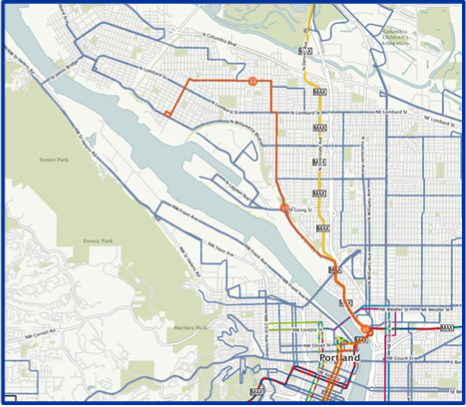
Map of TriMet’s Line 35 bus route in Portland. Credit: TriMet
Challenges and Lessons Learned from the IMI Demonstration Project
As with many large data projects, protecting privacy is critical. The Hop transaction datasets used in the IMI project had personally identifiable information attached to it, and since these platforms were designed to be open source, TriMet identified the potential for users to pick out a single rider’s trip patterns from the raw data. The project team worked closely with TriMet’s legal team on how best to properly safeguard personal information without restricting the ability to use and analyze the data in the aggregate.
In general, when working with user data, especially data related to travel, agencies should always keep data privacy at the forefront of their strategies. As using transaction data to inform and improve service planning becomes more widespread, building secure data management processes is increasingly important for agencies. TriMet’s data policies include stipulations that anyone (whether commercial or research partners) using any trip-specific data must sign a confidentiality agreement. Additionally, mobile or app identification values associated with rider accounts are changed monthly, and TriMet limited some user data that was available publicly. TriMet’s approach to data management and data privacy resulted in a longer development process for this project, but with more confidence in ensuring rider privacy.
TriMet recognized some limitations with the ODX Model, particularly with what data it could analyze. The ODX Model was only able to capture riders who paid fares using a Hop account. While this still produced enough data for accurate modeling, it only comprises about half of all TriMet riders. Furthermore, to adhere to the aforementioned data privacy practices, TriMet limited some potentially personally identifiable information from the ODX Model. These limitations did not significantly impact the functionality of the model, but present a potential blind spot.
Sharing Project Development and Resources
Throughout the course of the IMI program, TriMet has pursued several avenues to publicize project developments. One of these initiatives was the creation of the TriMet IMI dedicated webpage where the agency shares data, resources, and background information about the ODX Model, OTP, and the partnerships established through the IMI project. The website contains, among other resources:
- Links to the data and source code created in support of the ODX model and OTP
- A variety of key project documents, including a Mobility Performance Metrics Report, which includes the Project Data Management Plan and a RFP for a Smart Mobility Platform (SMP) Pilot Project
- A timeline, allowing interested parties to see exactly how far along specific aspects of the demonstration project were and track specific subtasks. As the project is now complete, this timeline serves as a way for users to not only explore the end results of the project, but also the process.
In addition to TriMet’s IMI project website, TriMet staff has presented on the development of the IMI project at conferences and workshops, including the Mobility Innovation Collaborative workshops in 2022 and 2023. Sharing the processes, challenges, and outcomes of developing innovative technology for smart mobility projects is key to supporting the knowledge sharing dissemination to serve the mobility industry at large. TriMet’s efforts to publicize the work done through the IMI program showcase how these types of innovative projects can impact the landscape of transportation in Portland and beyond, and further support the agency’s ethos of open and accessible mobility information.
Key Partners
OTP and the Smart Mobility Platform are complex and constantly evolving projects, which require close collaboration with many partners. Below is a list of key partners, their roles, and at what points they were involved. The list is not exhaustive, and TriMet also partnered with various software developers, research institutions, peer cities and transit agencies, and shared mobility providers throughout the process.
| Partner | Role | Project Phase |
|---|---|---|
| OpenPlans | Software development for OTP | Early development |
| Oregon Metro | Local government partner | Throughout |
| Portland Bureau of Transportation | Integration with transportation wallet program and Hop system; data sharing | Throughout |
| moovel | Integrated payment plan (MOD Sandbox); Mobile fare payments (IMI) | MOD Sandbox and IMI |
| IBI Group (acquired by Arcadis in 2022) | Project management; development of trip planner | MOD Sandbox and IMI |
| Cleared for Takeoff, Inc. | Geocoder development | MOD Sandbox (after January 2018) |
| Mapzen | Geocoder development | MOD Sandbox (until January 2018) |
| Conveyal | Application development and design | MOD Sandbox |
| Uber | Mobility data provider; advisor on integrated payment white paper | MOD Sandbox and IMI |
| Fehr & Peers | Geocoder testing; data collection and management; performance metrics and use cases | MOD Sandbox and IMI |
| Nelson\Nygaard | Transit analytics | IMI |
| INIT | Payment system integration | IMI |
| Plus QA | Accessibility testing; customer experience Surveys | IMI |
| Clevor Consulting Group | Developing the business case for integrated payments | IMI |
| Ready Credit | Retail network integrator and management | IMI |
| VISA | Fare payments; extending open payments; improving access for unbanked and underbanked riders | IMI |
| UrbanLogiq | ODX development | IMI |
Future Plans
As one of the country’s most innovative transit agencies, TriMet plans to continue to develop its MaaS and service planning tools to meet the needs of travelers in the Portland region and beyond. TriMet and its partners continue to refine the multimodal OTP platform, making it more effective, more user-friendly, and more scalable. The open nature of the planner means that not only can other agencies use it for their own purposes, but TriMet can then build on and incorporate improvements and updates made by those agencies into its own system.
After the conclusion of the IMI program in 2023, TriMet transitioned the ODX Model into full production, and continues to work with UrbanLogiq on regular software maintenance and continued development of the model outside of the IMI program scope. TriMet is also working with other peer agencies on knowledge sharing, including starting a program governance and steering committee to manage the platform.
Conclusion
Agencies recognize the evolving needs of their riders, and innovative technology enables them to meet those needs. Innovative data collection and analysis can help agencies identify mobility gaps and assist in service planning. Data standardization and open data impact how riders access information about shared mobility services, making for connected and functional mobility networks. Trip planning platforms like TriMet’s can incorporate all of these innovations into a user-friendly service that makes shared mobility more accessible and practical.
Even with a focus on innovative technology, TriMet has recognized that these tools only work with committed partnerships that embrace the value and benefits of open systems, and strong communication and coordination between those partners. Innovative technology projects like these require the technical and managerial expertise of a large collection of partners, and TriMet has put an enormous amount of effort into fostering these partnerships to ensure that the projects progress as smoothly as possible.
TriMet’s history of innovation also demonstrates the important role of grant funding for innovative mobility projects. From the Oregon Metro Regional Travel Options grant to the FTA’s MOD Sandbox and IMI programs, TriMet leveraged these opportunities to build upon each other to further the valuable development work for trip planning and data analytics tools.
Finally, TriMet’s initiatives show how innovation at the local level can spur positive change throughout the industry. The agency’s role in developing GTFS eventually led to the specification becoming the industry standard, used by transit agencies around the world. Using open data and open architecture was a priority for OTP, ensuring that other agencies, governments, and developers could use it, build on it, and improve it for everyone. TriMet’s work was also a foundational piece of a workgroup that developed The Path to Mobility Interoperability. This approach allowed for the emergence of a global community of developers to collaborate with each other, solve problems, and learn from each other.
TriMet has been leading the charge in fostering these communities, just as it has in developing and adopting innovative mobility technologies. With these pursuits, TriMet recognizes that its role as a public transit agency can be more than simply a purveyor of buses and trains, but a comprehensive, people-focused mobility management organization.
Additional Resources
- FTA Final Report: Mobility on Demand (MOD) Sandbox Demonstration: Tri-County Metropolitan Transportation District of Oregon (TriMet) OpenTripPlanner (OTP) Shared-Use Mobility
- FTA IMI Demonstration Project Factsheets
- TriMet STEPS to MOD & MPI: IMI Demonstration Program Statement of Work
- TriMet New Mobility Study: Strategic Business Review
- Meet Bibiana McHugh, Manager of Mobility and Location-Based Services at TriMet
- The OpenTripPlanner Project 2009-2011 Final Report
- Presentation on TriMet’s Smart Mobility Platform at the 2022 Mobility Innovation Collaborative Workshop on May 16, 2022
- Presentation on TriMet’s ODX at the 2023 Mobility Innovation Collaborative Workshop on May 2, 2023
- The Path to Mobility Interoperability